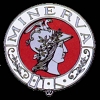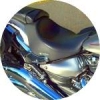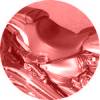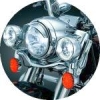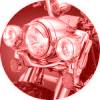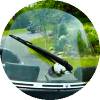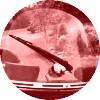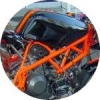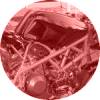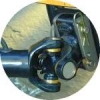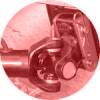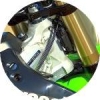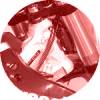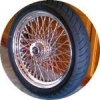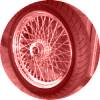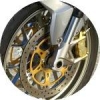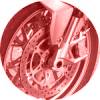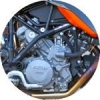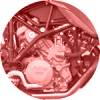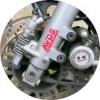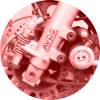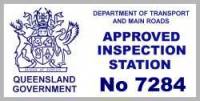Queensland Department of Transport and Main Roads introduced the safety certificate in November 1999 to replace the old roadworthy certificate or RWC, and it became
mandatory to obtain and display a current safety certificate on any registered motorcycle from the moment it's offered for sale.
The only times it's not required to display current safety certificate on a motorcycle for sale is when the motorcycle's either unregistered or is traded to or
between licensed motor dealers.
Queensland Department of Transport and Main Roads safety certificates can only be issued by Approved Inspection Stations (AIS), being service stations, garages or
workshops approved by Queensland Department of Transport and Main Roads to conduct inspections.
For private motorcycle sellers, Queensland Department of Transport and Main Roads safety certificates must be issued in the two months or 2000 kilometres prior to
sale, whichever comes first.
You are required to display a safety certificate in a conspicuous place and for motorcycles it's either on the forks or front guard.
Failure to display a Queensland Department of Transport and Main Roads safety certificate on the motorcycle from the time it's first offered for sale can carry an
on-the-spot fine penalty of $550.
Information on this website relating to motorcycle inspection is drawn from the Queensland Department of Transport and Main Roads Code of Practice for Approved
Inspection Stations (AIS) and Approved Persons; guidelines followed during safety certificate inspections and vehicle modification certification.
Following the code of practice guidelines below and rectifying faults you uncover should assure your motorcycle will pass on first inspection, avoiding any inconvenient
and possible costly re-inspection.
Vehicle inspection is subjective and the guidelines open to varying interpretation from inspector to inspector. Below are a list of reasons for possible rejection
pertaining to Body and Chassis for the issuing of a Queensland Department of Transport and Main Roads safety certificate (formerly roadworthy certificate or RWC).
SECTION 4 - BODY, CHASSIS AND FRAME
Objective: To ensure the vehicle body is structurally sound and free from any defects, protrusions or additional fittings that are likely to increase the risk of
bodily injury to any occupant and other road users.
In this section:-
Body kit components includes side skirts, front and rear spoilers and dress-up kits.
Door component includes doors, hatches, catches, safety catches, removable covers, internal and external handles and any fastening used.
Frame component includes a vehicle's chassis and body.
Moving part, for an L-group vehicle, includes chains, belts, road wheels, tyres or exhaust.
Mudguard includes any mudflap fitted.
4.1 HATCHES, HINGES AND CATCHES
Possible reasons for inspection rejection:
- Door components are not securely fitted and mounted or do not operate in the manner for which they were designed.
- Doors/hatches/hinges/catches are cracked, broken, distorted or corroded to the point where a component is weakened or failure of a
component is likely to occur.
- Door components (as applicable) are not fitted, secure or operating correctly.
4.2 BODY, CHASSIS AND FRAME (Floor Pan and Sub-frame)
Possible reasons for inspection rejection:
- A frame component is cracked, sagged, broken, distorted, missing or corroded to the point where a component is weakened or failure of a
component is likely to occur. (see Note 7)
- Any fastenings between frame component members, including welds, are not secured or are cracked or distorted.
- The body or any attachment/fitting is not securely mounted to the frame or chassis.
- Any repairs carried out do not retain the original strength of the component/section.
- Body blocks are fitted which lift the vehicle more than 50mm.
- Any panels, fittings and structural components (internal and external) have sharp edges and protrusions which would increase the risk
of injury to any person who comes into contact with the vehicle.
- Cargo anchorage points are structurally damaged or repaired in a manner that does not retain the original strength of the
component.
4.4 BODY FITTINGS
Possible reasons for inspection rejection:
- A part of the vehicle/trailer or component fitted to it obscures any compulsory lighting or the number plate.
- Fairings or any attachments are not free of sharp edges or protrusions, corrosion, fractured panels or fittings likely to cause injury
to any person with whom the motorbike may come into contact.
- Motorbikes are not fitted with adequate protection (for rider and passenger) from any moving part or any area which would constitute a
safety hazard.
- A side-car (if fitted) is not securely attached and mounted to the left hand side of the motorbike. (See Note 5)
- Any part of a motorbike (without a side-car) projects more than 150mm ahead of the front wheel or 300mm behind the rear wheel.
4.5 MOTORBIKE RIDING CONTROLS
Possible reasons for inspection rejection:
- Riding controls are not securely fastened or not in the correct location as per the relevant ADR for date of manufacture.
- The incorrect number of footrests are fitted (as per the seating capacity of the motorbike).
- Footrests are bent, damaged or not secure.
4.6 MUDGUARDS AND WHEEL ARCHES
Possible reasons for inspection rejection:
- The mudguards are not secure.
- Mudguards are not capable of deflecting downwards any mud, water, stones or any other substance thrown upward by the rotation of the
wheels. (See Note 2 and 6)
- Mudguards are not properly fitted to provide protection over the full width of the wheels and tyres and any mudguard does not extend
inboard over the full width of the tyre/s (except where part of the body of the vehicle acts as a mudguard).
- The front mudguard does not shield that portion of the wheel extending rearward from a point vertically above and horizontally behind
the centre of the front wheel.
4.7 REAR VISION MIRRORS
Possible reasons for inspection rejection:
- Rear vision mirrors are not fitted in accordance with prescribed standards. (See Note 3)
- Rear vision mirrors fitted to any vehicle do not provide a clear view of the road to the rear of the vehicle when the operator is in a
natural driving/riding position.
- Mirrors are not securely mounted or free from damage, blemishes or tarnishing which would reduce the view to the rear of the
vehicle.
- Where there is no effective rear vision provided by the internal rear vision mirror, the vehicle does not have an external rear vision
mirror fitted to each side of the vehicle.
4.8 FAIRINGS AND SCOOPS
Possible reasons for inspection rejection:
- Bonnet scoops are not fitted in accordance with prescribed standards. (See Note 10)
- Body kit components (if fitted) adversely affect ground clearance and air flow for brake cooling. (See Note 4)
- Surfaces that could reflect light towards the driver are not non-reflective.
4.9 NUMBER PLATES
Possible reasons for inspection rejection:
- Number plate covers are tinted, reflective, have a convex or concave surface, or in some way may affect visual or photographic
recognition of the registration number.
- A number plate is deteriorated, faded or damaged to an extent that the registration number is not legible from a distance of 20
metres.
- A number plate is modified or trimmed in any way (for example, cutting or bending to aid fitting to the vehicle).
- Number plate characters are not visible from any point within an arc of 45 degrees at a distance of 20 metres above and on both sides
of the number plate.
- Number plate is mounted more than 1300mm from the ground.
- A number plate is mounted which is not in an upright position parallel to the vehicle's axles when the vehicle is on level ground.
- The registration number and/or plate is not issued or approved by a State or Territory Road Transport Authority.
Notes about Section 4 (Body, Chassis and Frame):
[1] For guidance on recommended bull bar profiles refer to AS 4876.1-2002
[2] Further information on mudguards and mudflaps is contained in Information Sheet No. 3 in Vehicle Standards Instruction G21 - Information Sheets for Approved
Examiners.
[3] At least one rear vision mirror must be fitted to a car (after 1 January 1972, an external rear vision mirror must be fitted to the right side of a car - refer to
details of ADR 14 for other vehicle ADR applicability dates).
At least one rear vision mirror must be fitted to each side of a motorbike with one front wheel built after June 1975.
ADR 14/02 now permits the use of a driver's side and internal convex rear view mirrors. Additionally, left side convex rear view mirrors are acceptable.
Older vehicles are permitted to be fitted with convex mirrors provided they comply with the ADRs.
Rear vision and reversing cameras are considered accessories (cannot replace the mandatory rear vision mirrors) and therefore are not required to operate.
[4] Further information on ground clearance is contained in Information Sheet No. 13 in Vehicle Standards Instruction G21 - Information Sheets for Approved
Examiners.
[5] Motorbike sidecars with bolt on attachment points are acceptable. Motorbike sidecars with welded on attachment brackets require approval from the Department of
Transport and Main Roads.
[6] Further information on motorbike mudguards is contained in Vehicle Standards Instruction M4.1 - Motorcycle mudguard requirements.
[7] Minor rust/corrosion in body panels is not considered dangerous to structural integrity. Further information on rust is contained in Information Sheet No. 11 in
Vehicle Standards Instruction G21 - Information Sheets for Approved Examiners.
[8] Any trailer which is more than 2.2 metres in width and fitted with a body which is less than 300mm in height at the rear, measured from the lowest point of the
body above the ground to the highest point, does not have the rear face of any rear mudguards painted silver or white.
[9] The rear coaming of any trailer described above is not painted silver or white in colour for a depth of 75mm or more. The above does not apply when a vehicle is
correctly fitted with rear marker plates.
[10] Further information on bonnet scoops can be found in the LZ section of the National Code of Practice for Light Vehicle Construction and Modification.
















